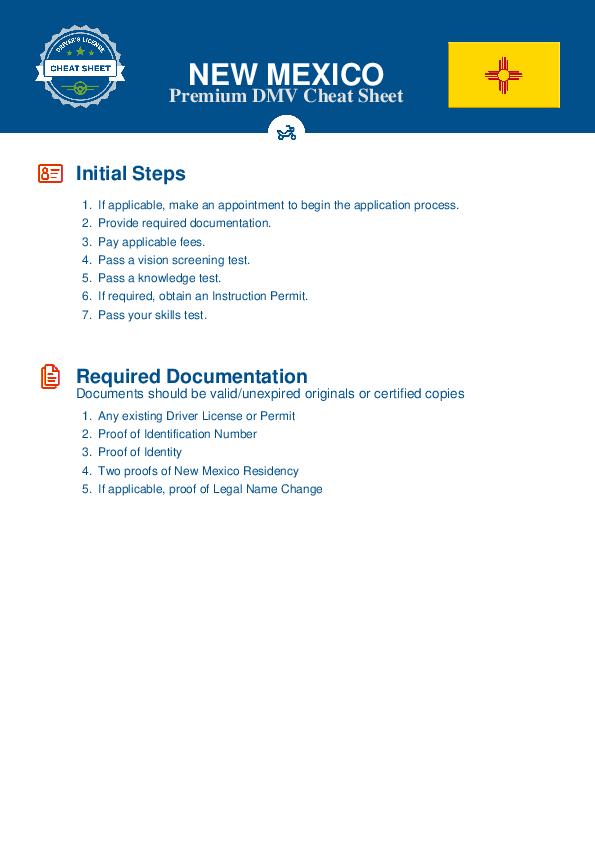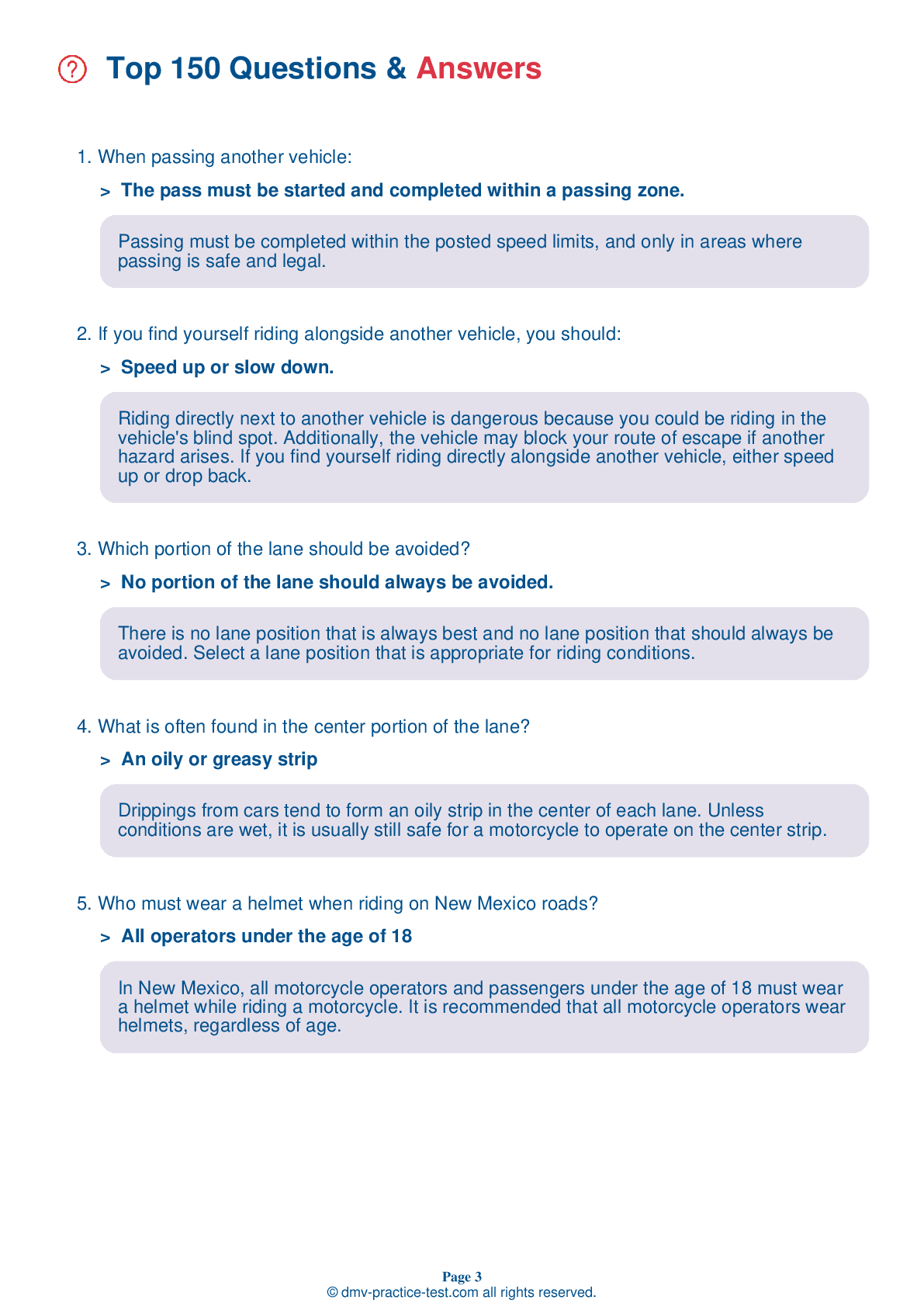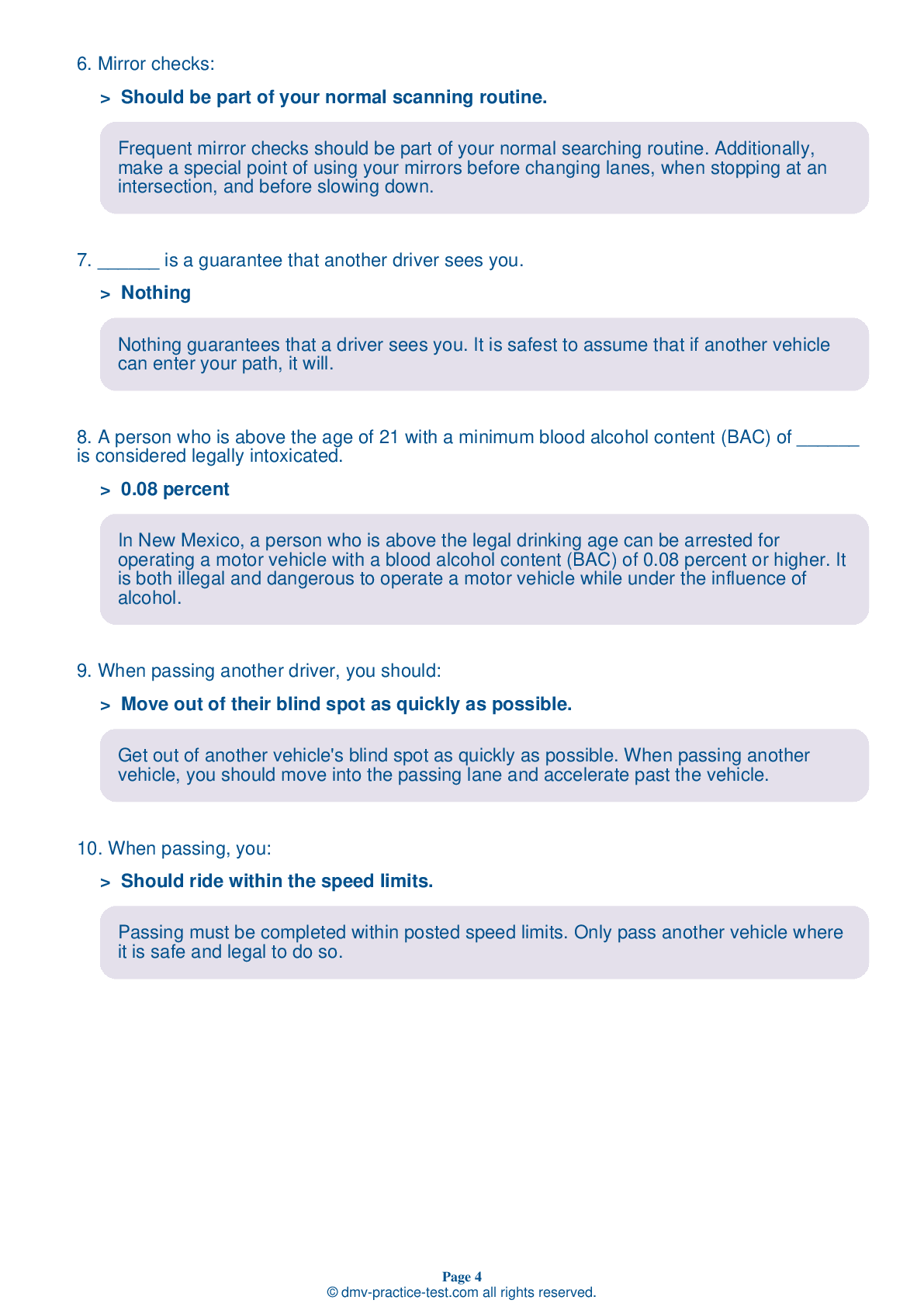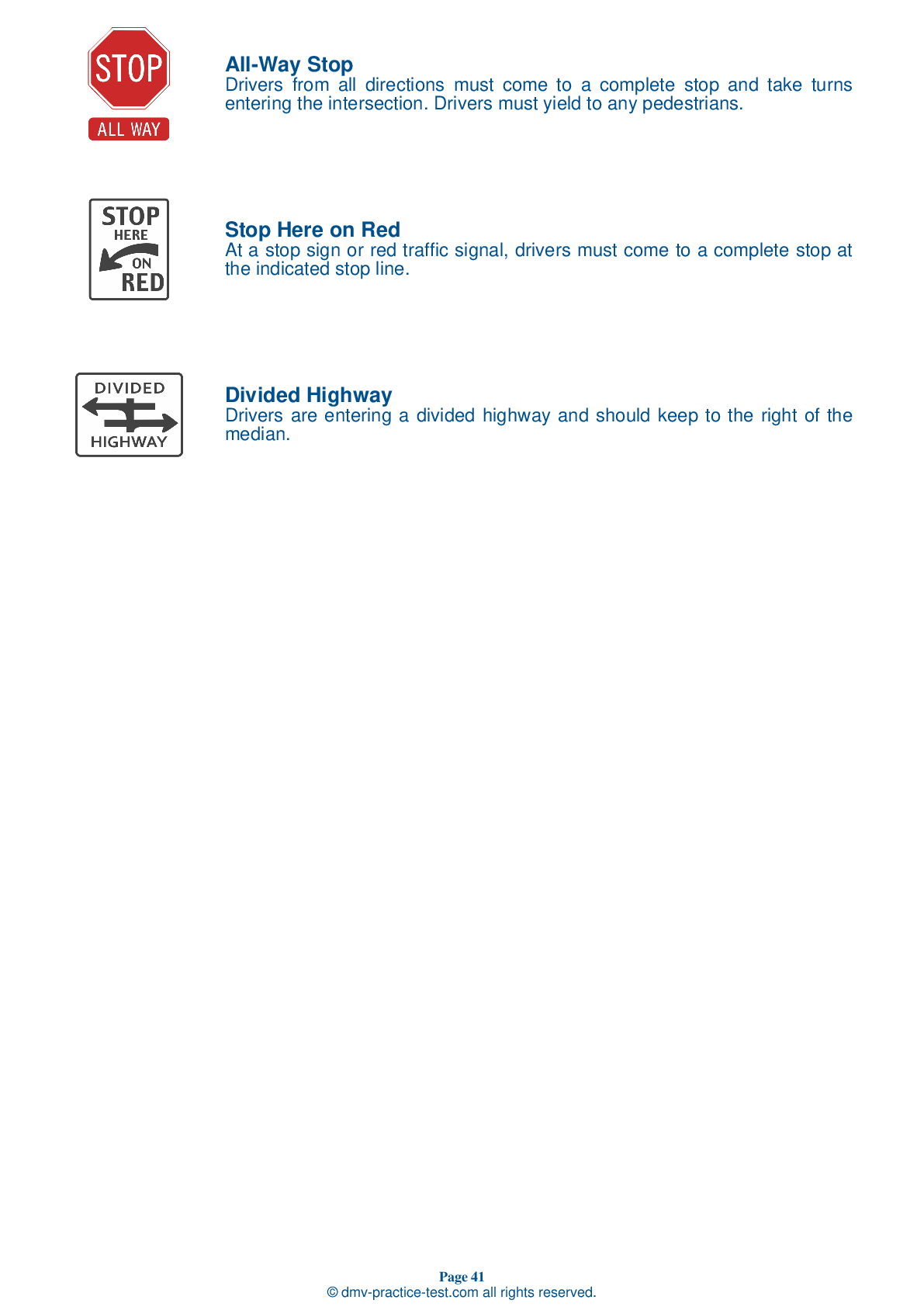DMV Permit Test #13
Motorcycle Test | License NM 2025 | FREE Online Practice! #13
Take this FREE motorcycle test (license in NM 2025) to check your knowledge of the road rules. To improve your results, download a motorcycle handbook online, study theory, and practice for free on our website. Still worried about how to get a motorcycle license in New Mexico in 2025? Check our website for more sample tests, train as much as possible, and boost your grades!
25
20
16
1 . Your lane position should not:
Provide you with an escape route.
A properly chosen lane position should provide a number of benefits, including an increased ability to see others and to be seen. It should help you avoid wind blasts, other drivers' blind spots, and surface hazards. Your lane position should discourage other drivers from trying to share your lane and provide you with an escape route, should a hazard arise.
2 . To stop quickly, you should:
Use the rear brake firmly while gradually increasing the braking pressure of the front brake.
To stop quickly, apply both brakes at the same time.
3 . When riding behind a car, you should:
Ride in the far right portion of the lane.
When riding behind a car, you should position yourself so you can be seen in the other driver's rearview mirror. Riding in the center portion of the lane will generally ensure that you will appear in the middle of their rearview mirror, where the driver is most likely to notice you.
4 . When riding with a passenger, the operator should:
Not warn passengers of impending hazards.
Because a motorcycle handles differently when under the weight of a passenger, an operator should maintain a larger space cushion when transporting another person.
5 . A danger of riding next to a row of parked cars is:
The road may be uneven.
Riding next to parked cars presents a number of potential dangers. A driver might pull out of parking space and into your path without looking. Car doors may be opened into your lane and pedestrians may step out from between cars.
6 . Which of the following will help you ride safely on slippery surfaces?
Maintaining or increasing your speed
When riding on slippery surfaces, reduce your speed, brake using both brakes, and avoid sudden moves. Avoid the center of the lane and instead follow tire tracks left by cars. Always keep an eye out for hazards that may make a road surface especially slippery, such as oil spots and loose gravel.
Need Motorcycle Insurance? No problem!
Compare the best rates in New Mexico and find a personalized policy that meets your needs.
1. Are You Currently insured ?
2. Married ?
3. Do you own your Home?
4. Have you or a Family Member Honorably Served in U.S. Military ?
5. Your Name
6. Age
7. Zip code
Ranked by best match
2025 New Mexico | Frequently Asked Questions
To acquire a motorcycle license in New Mexico, you must first obtain a motorcycle learner's permit by passing a written test. After practicing with the permit for a minimum of six months, you can take the road test to get your license. Alternatively, completion of a Motorcycle Safety Foundation course can waive the road test requirement.
In New Mexico, the minimum age for obtaining a motorcycle driver's license is 13 years old. However, riders under the age of 18 must complete a state-approved motorcycle safety course and hold a motorcycle learner's permit for at least six months before they can apply for a full motorcycle license.
Yes, you do need a dedicated license for motorcycle riding in New Mexico. This is called a motorcycle endorsement and can be added to your existing driver's license. To get this endorsement, you must pass a written test and a road skills test. If you're under 18, you're also required to complete a state-approved motorcycle safety course.
To apply for a motorcycle license in New Mexico, you will need a valid identification document (like a birth certificate or passport), proof of your Social Security number, two proofs of New Mexico residency, and a completed application form. If you're under 18, you'll also need a parent or guardian's signature.
Yes, you will need to take a written exam to get a motorcycle license in New Mexico. This test is designed to assess your understanding of motorcycle operation, traffic rules, and safety practices. If you successfully complete a state-approved motorcycle safety course, the written test requirement may be waived.
The motorcycle written test in New Mexico covers a variety of topics related to motorcycle safety and operation. These include traffic laws, road signs, handling dangerous situations, and motorcycle maintenance. It also tests your knowledge on protective gear, passenger rules, and alcohol/drug influence on riding. The test is designed to ensure you understand safe riding practices.
Yes, in New Mexico, completing an approved Motorcycle Safety Foundation course can waive the written and road test requirement for a motorcycle license. Upon completion, you will receive a certificate which you can present at the Motor Vehicle Division as proof of your successful completion and bypass the tests.
To enroll in a motorcycle training course in New Mexico, you need to find a state-approved provider. Once you've selected a program, you can register online or over the phone. The course typically includes both classroom instruction and hands-on training. You'll need to pay a registration fee, which varies depending on the provider.
No, you don't necessarily need to own a motorcycle for the license test in New Mexico. You can use a borrowed motorcycle as long as it is registered, insured, and passes the safety inspection. However, you must be comfortable and familiar with the motorcycle you're using for the test.
Yes, you can use a friend's motorcycle for the driver's license evaluation in New Mexico. However, the motorcycle must be legally registered and insured, and it must pass a safety inspection conducted by the Motor Vehicle Division examiner before the test. Make sure you are familiar with the motorcycle's controls and operation.
Yes, in New Mexico, the motorcycle driving exam tests specific handling skills including starting and stopping, turning and swerving, and negotiating intersections. It also assesses your ability to balance, control speed, and perform quick stops. Knowledge of motorcycle safety rules and road signs is also tested during the written portion of the exam.
In New Mexico, new motorcycle drivers under 18 are subject to certain restrictions. They must complete a Motorcycle Safety Foundation course, cannot carry passengers, and are prohibited from riding at night for the first six months. These restrictions aim to ensure the safety of new riders as they gain experience on the road.
Yes, your New Mexico motorcycle license or endorsement is valid throughout the United States, allowing you to ride a motorcycle in any state. However, it's crucial to be aware of and comply with each state's specific motorcycle laws and regulations, as they can vary. Always ensure you carry your license while riding.
In New Mexico, all motorcycle riders and passengers under the age of 18 are required to wear a helmet. Although it's not mandatory for those 18 and older, it's strongly recommended for safety. The helmet must meet the standards set by the U.S. Department of Transportation to provide adequate protection.
In New Mexico, there are two types of motorcycle licenses: a motorcycle-only license and a motorcycle endorsement for your standard driver's license. The motorcycle-only license allows you to operate only motorcycles, while the endorsement allows you to drive both motorcycles and other vehicles covered by your standard driver's license.
Yes, you can add supplementary endorsements to your motorcycle license in New Mexico. These endorsements could include permission to operate different types of motorcycles or other vehicles. Each endorsement requires passing a different written and skills test. Contact your local New Mexico MVD office for specific information on requirements and procedures.
Yes, the motorcycle license test in New Mexico can be taken in languages other than English. The test is available in Spanish, and other languages may be available upon request. However, it's always best to contact your local Motor Vehicle Division office beforehand to confirm the availability of your preferred language.
An effective strategy to prepare for the motorcycle license test in New Mexico is to study the Motorcycle Operator Manual thoroughly. It provides detailed information on rules and safety procedures. Also, taking online practice tests can be extremely helpful as they simulate the actual test format and help you understand the type of questions asked.
Yes, the motorcycle written exam in New Mexico can be taken in languages other than English. It's offered in Spanish, and other languages may be available upon request. However, it's advisable to confirm language availability with the local Motor Vehicle Division office prior to scheduling your exam.
If you don't pass the motorcycle written test in New Mexico, you can retake it. However, you must wait at least one day before retesting. If you fail three times, you'll need to wait six months before attempting again. There may also be additional fees for each retake. It's recommended to study the New Mexico Motorcycle Operator Manual thoroughly before retesting.



